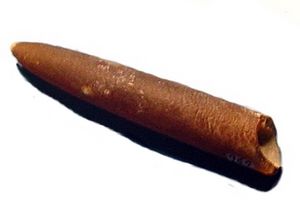Paleontology in Delaware facts for kids

Paleontology in Delaware is all about finding and studying fossils in the state of Delaware. It also includes research done by people from Delaware. Delaware doesn't have very old rocks from the Precambrian, Paleozoic, Triassic, or Jurassic periods. This means its fossil story really begins in the Cretaceous period.
During the Early Cretaceous, Delaware was slowly getting covered by the sea. By the Late Cretaceous, much of it was underwater. Amazing sea creatures lived here, like cephalopods (think squid-like animals) such as Belemnitella americana. There were also huge marine reptiles. On the land that was left, you could find different plants, dinosaurs, and flying pterosaurs. Delaware, along with New Jersey, is one of the best places in the eastern United States to find Late Cretaceous dinosaur fossils. Even in the Cenozoic era, Delaware was mostly covered by the sea. Marine animals like manatees, porpoises, seals, and whales swam in these waters. Later, during the Ice Age, glaciers shaped the land. The Cretaceous belemnite Belemnitella americana is even the official state fossil of Delaware!
Contents
Ancient Life in Delaware
Delaware's oldest rocks from the Precambrian and Paleozoic eras don't have fossils. This is because these rocks have changed a lot over time due to heat and pressure. They are called metamorphic rocks. Also, there are no local rocks from the Triassic or Jurassic periods, so no fossils from those times either.
Cretaceous Period: Dinosaurs and Sea Creatures
However, we do find many Cretaceous rocks and fossils! As the Early Cretaceous period ended and the Late Cretaceous began, Delaware changed from a land area to a shallow sea. Many plant fossils show us what the land looked like back then.
On land, there were different kinds of dinosaurs, including plant-eating hadrosaurs and speedy ornithomimids. Flying pterosaurs soared through the skies. Other reptiles included huge alligator-like creatures called Deinosuchus and giant marine lizards called Mosasaurs, like Globidens.
In the Cretaceous seas, there were many invertebrates (animals without backbones). These included annelids (worms), cephalopods (like squid), crustaceans (like crabs), gastropods (snails), and pelecypods (clams). One common crab fossil found in Delaware is Callianassa mortoni. You can often find its claws in the Merchantville Formation. A fast-swimming belemnite called Belemnitella americana was also common. Scientists have also found mysterious tube-like trace fossils called Halymenites major, which show signs of ancient life. Huge marine reptiles also lived in the sea that covered the state. Delaware is a top spot for finding Late Cretaceous dinosaur fossils in the eastern United States, just like New Jersey.
Cenozoic Era: Whales, Mammals, and More
Delaware was still mostly covered by seawater during the Cenozoic era, which followed the age of dinosaurs. The sea level went up and down over millions of years. In the ocean, you could find manatees, porpoises, seals, and whales. On the land areas, there were bears, beavers, dogs, and snakes.
About 17.5 million years ago, during the Miocene epoch, over 100 types of mollusks lived off the Delaware coast. Other sea animals included bony fishes, rays, sea cows, sharks, and sea turtles. Fossil pollen tells us that the coast back then was less marshy than it is today. Forests of oaks, palms, and pines grew there. The climate might have been similar to southern Georgia today.
On land, there were beavers, a possible saber-toothed cat, chalicotheres (strange hoofed mammals), deer-like animals, rabbits, peccaries (pig-like animals), hornless rhinoceroses, and small, early horses. Later, during the Ice Age, glacial activity left behind a lot of sand and gravel. However, these deposits didn't preserve many fossils.
Amazing Fossil Discoveries
The Smyrna Fossil Site
In the summer of 1991, construction workers were digging for a highway project near Smyrna. They found a very important Miocene fossil site! Most of the fossils were from sea creatures. But the mammal fossils found there were considered the best discovered north of Florida in the eastern United States.
Excavators dug down 50 feet to find both invertebrates and vertebrates. The invertebrates included over 100 kinds of sea mollusks. About a quarter of these had never been seen by scientists before! The famous mammal fossils from this site included beavers, a possible saber-toothed cat, chalicotheres, deer-like animals, rabbits, peccaries, hornless rhinoceroses, and small, early horses.
Scientists think this site might have formed in a couple of ways. Maybe land animals died, and their bodies floated downstream and out to sea, mixing with marine life. Or perhaps they died and were buried on land, and then the sea later eroded the sediments, bringing the fossils to light.
Natural History Museums
If you want to see some amazing fossils and learn more, you can visit these museums in Delaware:


